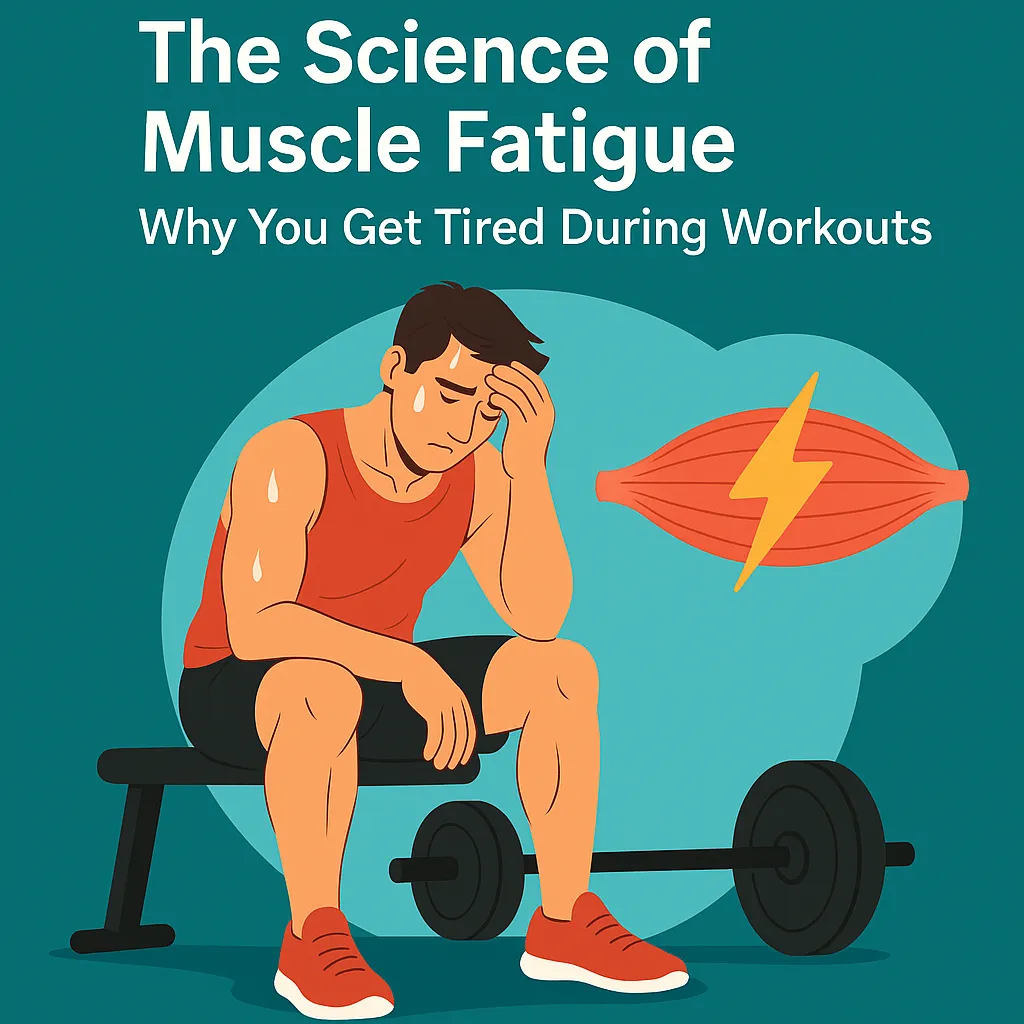
Introduction
When you hit the gym or go for a run, that burning sensation in your muscles can be both a signal of progress and a sign that you’re reaching your limits. Muscle fatigue is a natural part of exercise, yet it’s also one of the most misunderstood phenomena in exercise physiology. This article delves into the fascinating world of muscle fatigue, exploring why your body gets tired during workouts and providing actionable tips to optimize your training. In simple terms, understanding the science behind body fatigue can help you push through those difficult moments and train smarter.
Definition of Muscle Fatigue
Muscle fatigue is the decline in the muscle’s ability to generate force. It occurs due to a combination of factors ranging from biochemical changes to neural pathways becoming less effective over time. This sensation of tiredness isn’t just about feeling weak; it’s also about the chemical and physical alterations happening inside your muscles.
Importance of Understanding Fatigue
Why is it important to understand muscle fatigue? Simply put, this knowledge can lead to more efficient workouts, reduce your risk of injury, and help you design better recovery strategies. Recognizing the signals your body sends can also empower you to find the right balance between push and recovery, ensuring long-term fitness and health.
The Physiology of Muscle Fatigue
Understanding the physiology behind muscle fatigue requires a deep dive into how your muscles work during exercise. Every rep, every sprint, every weight lifted is part of a complex chain reaction in your body.
The Role of Energy Systems in Workouts
Your body uses different energy systems to fuel physical activity, and each system plays a role in muscle fatigue:
- ATP-PC System: This system provides quick bursts of energy for short, explosive movements but depletes rapidly.
- Glycolytic System: Involved in medium-intensity activities, this system breaks down glucose to produce ATP, producing metabolic byproducts in the process.
- Oxidative System: Dominating longer-duration exercises, this system utilizes oxygen to generate energy and is more sustainable but slower to activate.
Each energy system has its limitations and contributes differently to the sensation of fatigue.
Muscle Fiber Types and Fatigue
Not all muscles are created equal. Different muscle fibers react and adapt to exercise in unique ways.
Fast-Twitch vs. Slow-Twitch Fibers
- Fast-Twitch Fibers: These are responsible for rapid, powerful movements. However, they fatigue quickly because they rely heavily on anaerobic metabolism, which produces lactic acid.
- Slow-Twitch Fibers: Better suited for endurance, these fibers are more fatigue-resistant due to their efficient use of oxygen. They sustain prolonged activities with less accumulation of fatigue-inducing substances.
The balance between these fibers in your muscles will dictate not only your strength and speed but also how quickly you tire during workouts.
Causes of Muscle Fatigue
Muscle fatigue isn’t caused by a single factor—it’s the result of various interrelated processes.
Metabolic Factors
One primary contributor to muscle fatigue is the buildup of metabolic byproducts. When muscles contract, they produce substances such as hydrogen ions and inorganic phosphate, which can interfere with the ability of muscle fibers to contract effectively. Over time, this leads to the decline in performance often experienced as extreme fatigue and body aches.
Neural Factors
The nervous system plays a critical role in muscle contraction. As exercise continues, neural signals may weaken, resulting in less effective muscle fiber stimulation. This body fatigue due to neural inefficiency can contribute significantly to the overall tiredness you feel during an intense workout.
Environmental Influences
Environmental conditions such as temperature, humidity, and altitude can also affect muscle performance. Training in a high-temperature environment, for instance, can increase sweating and lead to exhausted body aches if hydration and electrolyte levels aren’t properly maintained.
The Science Behind Body Fatigue and Muscle Pain
Biochemical Reactions Leading to Fatigue
At the heart of muscle fatigue are several biochemical reactions that occur during exercise:
- Energy Depletion: As ATP (adenosine triphosphate) levels drop, muscles lose their ability to function at peak performance.
- Accumulation of Metabolites: Byproducts like lactic acid accumulate, disrupting enzyme activities and causing discomfort.
- Ion Imbalance: The flow of calcium, sodium, and potassium ions becomes disrupted, leading to inefficient muscle contractions.
These processes collectively contribute to the feeling of an aching body and tiredness during and after workouts.
Lactic Acid and Its Effects
Lactic acid is often cited as the culprit behind muscle soreness, but its role is more complex. While lactic acid accumulation is associated with the burning sensation during intense exercise, it also serves as a temporary energy source. The body’s ability to clear lactic acid efficiently is linked to improved fitness levels and better exercise performance over time.
Understanding this balance can help you manage your workouts better and plan adequate recovery periods, reducing body pain and fatigue post-exercise.
Exercise Physiology and Fatigue
How Different Workouts Impact Fatigue Levels
Different types of exercise stress the body in unique ways:
- Strength Training: Typically relies on fast-twitch fibers and anaerobic energy systems, leading to rapid fatigue.
- Endurance Training: Primarily engages slow-twitch fibers and oxidative pathways, which delay fatigue but can lead to prolonged body aches fatigue after long sessions.
- HIIT (High-Intensity Interval Training): Combines bursts of intense activity with rest periods, challenging both anaerobic and aerobic systems.
Your choice of workout affects not just muscle strength but also how quickly you experience tired fatigue body aches.
Role of Hydration and Nutrition
Proper hydration and nutrition are critical in managing muscle fatigue. Dehydration can exacerbate fatigue, while a balanced diet helps replenish energy stores and supports recovery.
Electrolyte Balance and Its Importance
Electrolytes like sodium, potassium, and magnesium play a crucial role in muscle contraction and relaxation. An imbalance can lead to increased muscle cramps and aching body and tiredness. Ensuring that you replace electrolytes lost through sweat is an essential part of any fitness regimen.
Prevention and Management of Muscle Fatigue
While muscle fatigue is inevitable, there are strategies to manage and even mitigate its effects.
Warm-Up and Cool-Down Techniques
A proper warm-up prepares your muscles for the rigors of exercise. Gradually increasing the intensity allows your body to adjust, reducing the shock to your muscles. Conversely, cooling down helps your body transition back to a resting state, aiding in the removal of metabolic waste and reducing post-exercise stiffness.
Recovery Strategies
Effective recovery is just as important as the workout itself. Incorporating adequate rest, active recovery days, and self-massage techniques such as foam rolling can significantly reduce muscle soreness and extreme tiredness and aching body sensations.
Sleep and Nutrition
Never underestimate the power of a good night’s sleep and a balanced diet. Sleep is the time when your body repairs itself, and a nutrient-rich diet provides the building blocks needed for muscle recovery. Foods high in protein, antioxidants, and anti-inflammatory compounds can help reduce body aches and fatigue.
Training Strategies to Overcome Extreme Fatigue
Changing the way you approach your workouts can lead to better overall performance and reduced fatigue.
Progressive Overload
This strategy involves gradually increasing the intensity, duration, or frequency of your workouts. By steadily challenging your muscles, you allow them to adapt and grow stronger over time, thereby reducing the onset of fatigue and minimizing muscle fatigue during routine exercise.
Cross-Training and Active Recovery
Incorporating a variety of workouts into your routine can reduce overuse injuries and combat the monotony that might lead to exhausted body aches. Cross-training allows one set of muscles to rest while another is engaged, promoting overall balance and efficiency. Active recovery—such as light walking, swimming, or yoga—helps increase blood flow to tired muscles, speeding up the recovery process.
Must-Read Resources
For readers who want to dive deeper into the science behind muscle fatigue and enhance their understanding of exercise physiology, here are some reputable websites offering insightful articles, research, and expert advice:
- American College of Sports Medicine – Explore cutting-edge research and professional guidelines on exercise, performance, and muscle physiology at acsm.org.
- Mayo Clinic – Get reliable health information, including expert advice on exercise, muscle fatigue, and recovery strategies at mayoclinic.org.
- Harvard Health Publishing – Find articles on exercise science, muscle fatigue, and overall well-being, written by top experts at health.harvard.edu.
- National Institutes of Health (NIH) – Access peer-reviewed research and comprehensive articles on exercise physiology and related health topics at nih.gov.
- PubMed – Search through a vast database of medical research papers for the latest studies on muscle fatigue and exercise science at pubmed.ncbi.nlm.nih.gov.
These resources offer a wealth of information that can help you better understand the intricacies of muscle fatigue, improve your workout routines, and manage recovery effectively.
Conclusion
Understanding the science of muscle fatigue is pivotal for anyone looking to optimize their workout routines and enhance overall exercise performance. From the role of energy systems in our muscles to the intricate balance of electrolytes and neural signals, every aspect of fatigue is interconnected. With this knowledge, you can better prepare for and recover from physical exertion, manage body pain and fatigue, and ultimately achieve a healthier, more sustainable fitness journey. Remember, every athlete experiences fatigue—it’s the adaptations and recovery strategies that define success. Embrace the science, listen to your body, and adjust your training to harness your full potential.



